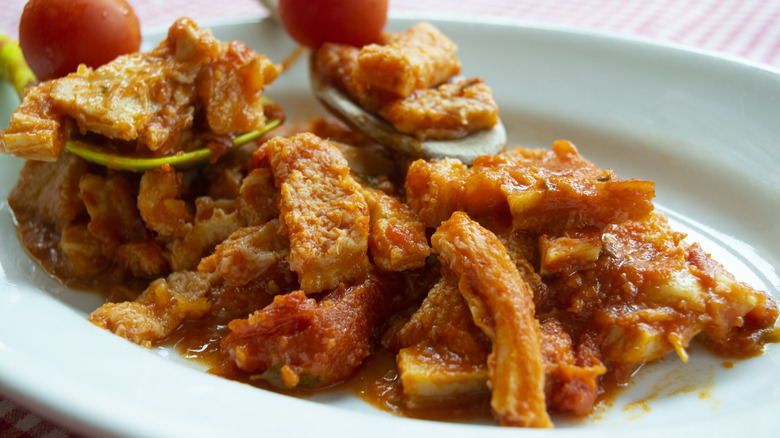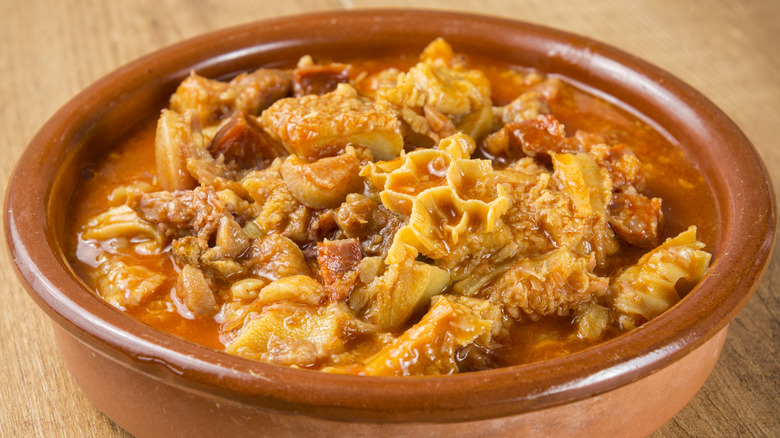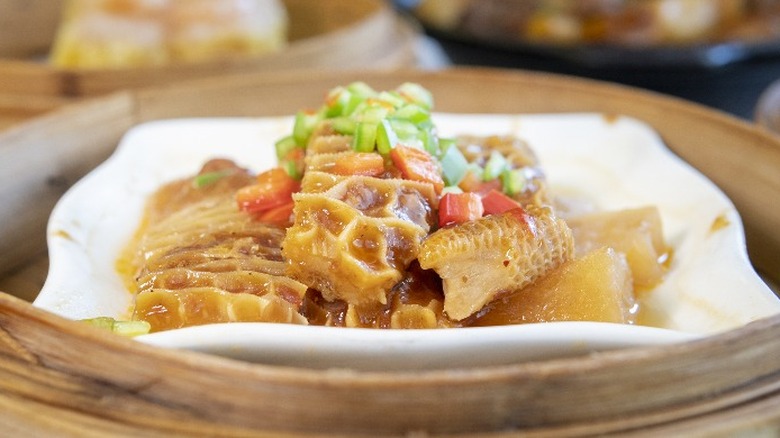What Is Tripe And When Is It Edible?
While many Americans may be unfamiliar with the concept, there exists a whole culinary universe built around the stomach lining of cows, known as tripe in its edible form. Cultures all across the globe, from China to Italy to the Caribbean, are already familiar with the chewy and absorbent meat offering. Properly prepared tripe has a mild, liver-like taste that pairs well with herbs and aromatics, and it's a common staple of stews, soups, and curries, and all sorts of boiled and braised dishes.
The methods of choosing and preparing tripe range far and wide, so it's a wonder that the dish hasn't caught on in the American mainstream considering its potential for diverse deliciousness. That may be due to a lack of familiarity with tripe's bumpy, rugged appearance and slippery mouthfeel; perhaps it's because of the social stigma around consuming organ meat in general; or maybe it's because Americans just don't grow up learning how to properly prepare tripe in order to make it edible, which is a bit of a drawn-out process. Tripe can't be consumed without a thorough cleaning and boiling process, but the labor is well worth the effort for anyone looking to add unique dimension of texture to a range of hearty recipes.
There are several types of tripe
A cow's stomach consists of four separate chambers in order to break down the tough, cellulose-heavy grass they eat, and there are different types of tripe corresponding to each of these sections.
The first and largest part of the stomach, the rumen, takes on the form of a flat piece of meat aptly named blanket tripe. Then there's the geometrically-patterned honeycomb tripe, the product of the reticulum that's the most commonly sold due to its tenderer consistency. The folded, layered book tripe (also known as Bible tripe) comes from the third stomach chamber, the omasum — which is what you'll often see it called in Asian markets and restaurants.All of these are prepared the same way, although the hexagons of the honeycomb tripe or the flaps of the book tripe may require just a tad more cleaning. There exists a fourth category of tripe taken from the abomasum section of the stomach, but this is more commonly used as a cheese-making ingredient rather than as a meal on its own.
It's also worth pointing out that although beef tripe is the most common form of stomach meat, pork and lamb tripe are also found in some recipes.
How to prepare tripe
Tripe is too loaded with digestive contaminants to consume straight from the source. Fortunately, butchers are well-versed in the art of dressing tripe, which consists of a good cleaning, trimming, boiling, and often a bleach soak, which gives the cut its signature white hue. The large majority of tripe sold in butcher shops and supermarkets are already dressed, and it's easy to spot an unbleached portion due to its brown-greenish color. Dressing tripe at home doesn't require bleaching, but your tripe does need a fat trim along with a good salt and vinegar bath and a thorough scrubbing.
Even dressed tripe must still be boiled in salt water and sometimes vinegar to tenderize the chewy meat, as well as help remove the chlorine odor that comes about as a result of the bleaching. The boiling time can range from over an hour to a quick, five-minute parboil, depending on the recipe. A well-cooked piece of tripe will still retain some of its chewy texture without wearing out your jaw. It also helps to cut the tripe into smaller, more manageable pieces.
After this cleaning and tenderizing process, you'll find that tripe is remarkably widespread in its use. It's easy to simply throw in a pot of soup, while it can also be steamed in a dim sum serving, stuffed in a Florentine lampredotto sandwich, or used as a casing for spiced filling. Once you have a bite, you'll find that it's actually pretty easy to stomach.



